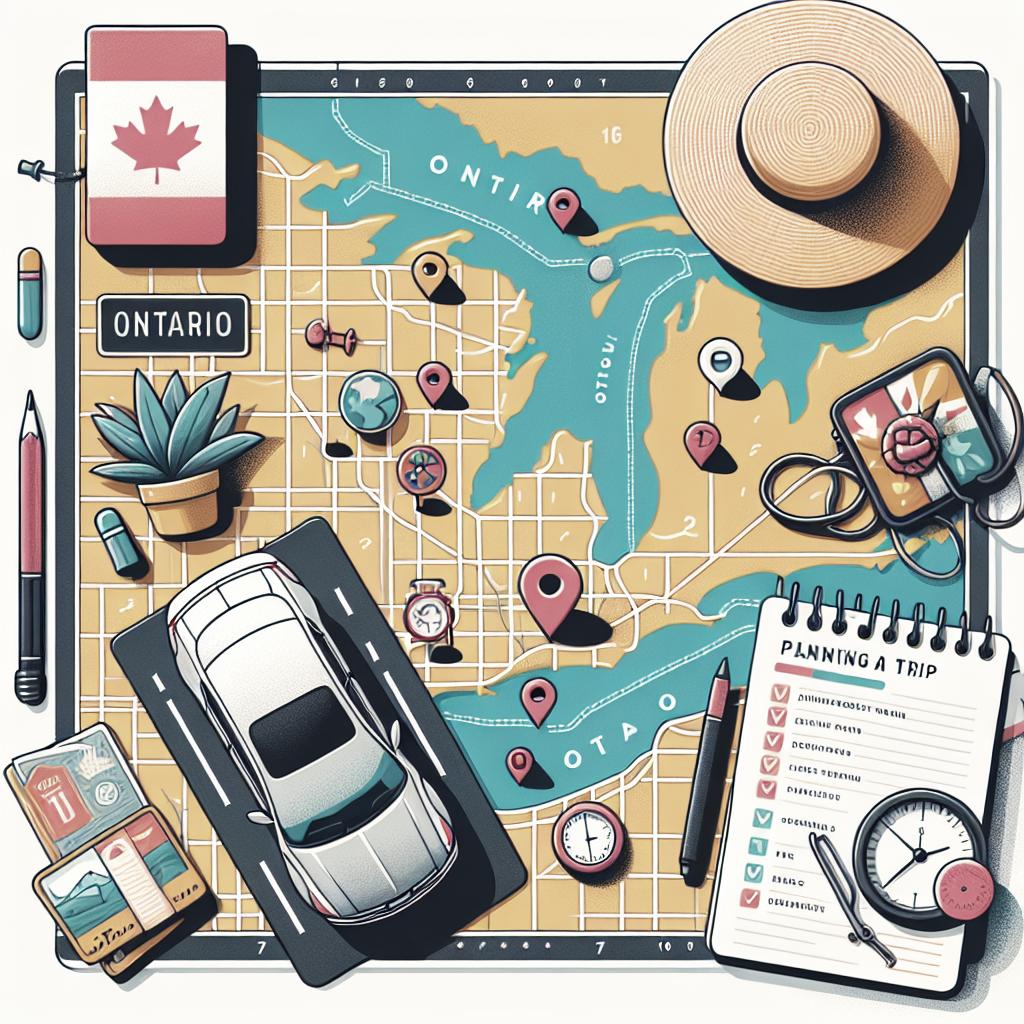Un road trip en Ontario offre des paysages époustouflants, des villes dynamiques et de nombreuses aventures à chaque tournant. Que vous soyez un voyageur expérimenté ou que ce soit votre première expédition sur la route, une bonne planification est essentielle pour tirer le meilleur parti de votre voyage. Dans cet article, nous allons explorer les étapes clés pour organiser un road trip réussit en Ontario. De la sélection de l’itinéraire à la réservation et aux détails pratiques, suivez notre guide pour une expérience inoubliable.
#1. Choisir son itinéraire
L’Ontario est une province vaste et diversifiée offrant une multitude d’options pour votre road trip. La première étape consiste à décider quels sites et régions vous souhaitez explorer. Vous pourriez opter pour un circuit urbain en visitant Toronto, Ottawa et Kingston, ou bien choisir un itinéraire plus nature avec le Parc National de la Péninsule Bruce, Algonquin Park ou encore les Chutes du Niagara.
Pour simplifier votre choix, listez les attractions et activités qui vous intéressent le plus. Considérez le temps dont vous disposez et la distance que vous êtes prêt à parcourir chaque jour. Les applications de cartographie en ligne et les guides de voyage peuvent être d’une grande aide pour visualiser les distances et planifier vos étapes.
#3. Modifiez votre road trip 100% sur mesure
3.1. Itinéraire
Créez un itinéraire qui correspond parfaitement à vos besoins et intérêts. Vous pouvez commencer par un itinéraire de base et le personnaliser en ajoutant ou supprimant des destinations. Ne surchargez pas votre emploi du temps; laissez de la place pour la spontanéité et les découvertes inattendues en chemin.
N’oubliez pas de vérifier les conditions routières et les heures d’ouverture des attractions à l’avance. La flexibilité est la clé pour un road trip réussi, alors prévoyez des alternatives si vos plans initiaux ne se déroulent pas comme prévu.
3.2. Voiture ou camping-car
Quel véhicule choisir pour votre road trip en Ontario? Une voiture compacte peut être idéale pour les voyages urbains et les routes bien entretenues, tandis qu’un camping-car offre plus de confort et de commodités pour les longs trajets et les sites naturels.
Évaluez les avantages et inconvénients de chaque option en fonction de votre itinéraire, de votre budget et de vos préférences personnelles. Réservez votre véhicule à l’avance pour garantir sa disponibilité et obtenir les meilleures offres.
3.3. Vols
Avant de débuter votre road trip, vous devrez peut-être prendre un vol pour atteindre votre point de départ en Ontario. Comparez les tarifs des différentes compagnies aériennes et choisissez des horaires de vol qui correspondent bien à votre planning.
Réservez vos billets le plus tôt possible pour bénéficier des tarifs les plus avantageux. Pensez également à vérifier les politiques de bagages et à prévoir le transport de l’aéroport à votre point de prise en charge du véhicule.
3.4. Prix
Établissez un budget complet pour votre road trip en Ontario, incluant les coûts de transport, d’hébergement, de nourriture et des attractions. Recherchez des offres spéciales et des réductions pour économiser sur les coûts totaux.
Préparez une réserve financière pour les impondérables tels que les réparations de voiture ou les frais médicaux. Garder une certaine flexibilité dans votre budget peut s’avérer utile en cas d’imprévus.
3.7. Contact
Avoir les coordonnées des hôtels, des attractions touristiques, des stations-service et d’autres points importants est crucial. Notez tous les contacts d’urgence et informations de secours, juste au cas où vous en auriez besoin.
Utilisez des applications mobiles pour stocker et organiser toutes ces informations, ce qui facilite leur accessibilité en cours de route. Gardez également une version papier comme plan de secours en cas de problème technologique.
#4. Réservez votre road trip
Une fois votre itinéraire finalisé, il est temps de passer à la réservation. Assurez-vous de réserver vos hébergements, activités et visites guidées en avance pour éviter les mauvaises surprises. Pendant la haute saison touristique, les disponibilités peuvent être limitées.
Pensez à confirmer toutes les réservations quelques jours avant votre départ. Gardez des copies de toutes vos confirmations de réservation et informations importantes à portée de main, soit en version numérique, soit imprimée.
Après la réservation
5.1. Guide de voyage
Investissez dans un bon guide de voyage pour l’Ontario. Les guides de voyage offrent des informations détaillées sur les attractions, les itinéraires recommandés, les restaurants et les hébergements.
Complétez les informations du guide avec des recherches en ligne pour des recommandations plus récentes et des avis de voyageurs. Un guide de voyage bien documenté peut faire toute la différence pour profiter pleinement de votre road trip.
5.2. Code de la route
Assurez-vous de bien comprendre le code de la route ontarien. Les règles de circulation peuvent varier d’une région à une autre, et il est crucial d’être au courant des spécificités locales pour éviter les amendes ou les accidents.
Respectez les limites de vitesse et les indications routières. En cas de doute, demandez conseil aux habitants ou consultez des ressources en ligne fiables sur le code de la route en Ontario.
5.3. Indications routières
Utilisez des applications de navigation mettant à jour les conditions routières en temps réel. Ces outils peuvent vous aider à éviter les embouteillages et à trouver les itinéraires les plus rapides et les plus sûrs.
Préparez également des cartes papier ou téléchargez des cartes hors ligne au cas où vous n’auriez pas accès à Internet. Une bonne préparation est essentielle pour éviter de vous perdre en chemin.
5.4. Infos pratiques
Informez-vous sur les conditions climatiques, les saisons touristiques et les événements locaux pouvant influencer votre voyage. Prenez en compte les variations de température et les conditions météorologiques extrêmes éventuelles en Ontario.
Ayez une trousse de premiers soins ainsi que les numéros d’urgence à portée de main. Préparez également une liste des stations-service et des aires de repos le long de votre itinéraire.
5.5. Vouchers
Rassemblez tous vos vouchers et confirmations de réservation dans un dossier que vous pourrez transporter facilement. Assurez-vous qu’ils sont accessibles à tout moment, surtout pour les hébergements et les attractions.
Utilisez des applications mobiles pour stocker numériquement vos vouchers, augmentant ainsi la commodité et réduisant le risque de perte. N’oubliez pas d’imprimer des copies de secours de vos documents importants.
5.6. Top 10 de mes photos de voyage
Ne perdez pas de vue l’importance de créer des souvenirs! Planifiez des arrêts pour capturer des photos mémorables de votre road trip. Les spots populaires comme les Chutes du Niagara et le Parc Algonquin offrent des opportunités photo incroyables.
Classez vos photos préférées pour un partage facile avec vos proches ou sur les réseaux sociaux. Envisagez d’investir dans un bon appareil photo ou utilisez votre smartphone pour immortaliser ces moments inoubliables.
LAISSER UN COMMENTAIRE
N’hésitez pas à partager vos propres expériences de road trip en Ontario ou à poser des questions. Les commentaires des autres voyageurs peuvent offrir des conseils pratiques et des recommandations personnelles pour enrichir votre propre voyage.
Répondre à:
Utilisez la section commentaires pour répondre aux questions ou aux suggestions d’autres lecteurs. Une interaction active avec la communauté des voyageurs peut vous fournir des informations utiles et des perspectives diversifiées.
3 commentaires
Lisez les commentaires des autres pour obtenir des idées supplémentaires et des recommandations pratiques sur l’organisation d’un road trip en Ontario. Cela peut aussi vous aider à éviter des erreurs courantes.
Réflexions finales
| Point clé | Description |
|---|---|
| Choix de l’itinéraire | Définir votre parcours en fonction de vos intérêts et du temps disponible |
| Véhicule approprié | Choisissez entre une voiture ou un camping-car selon vos besoins |
| Réservations | Réservez vos hébergements et activités à l’avance pour éviter les mauvaises surprises |
| Guides et informations pratiques | Utilisez des guides de voyage et des applications de navigation pour une meilleure préparation |
| Gestion des documents | Rassemblez tous les vouchers et confirmations de réservation dans un dossier accessible |
| Partage d’expériences | Interagissez avec d’autres voyageurs en ligne pour des conseils et des recommandations |


